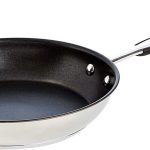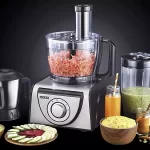Ravioli vs Tortellini - What's the difference?

Pasta is a staple of Italian cuisine. It’s plentiful, filling and relatively plain. There are many ways to prepare it.
The difference sometimes lies in the type of sauces that are used. In some cases, the shape of the noodles makes a difference.
With that being said, we love stuffed pasta recipes as they are incredibly unique and interesting. Although it may seem like a minor difference to some, the fact of filling the pasta gives the dish another layer of versatility.
Right now, there are two types of stuffed pasta that can’t help but come to mind. Namely, the ravioli and the tortellini. It could be said that they are the most popular versions of the stuffed pasta.
What is the difference between ravioli and tortellini? Ravioli are flat squares of egg noodles that are filled with ricotta and can also contain mushrooms, pork or other ingredients. Tortellini are folded into a ring or naval shape and filled with Parmesan, pork, or perhaps other ingredients.
Both filled pasta originate from Italy, but they have some fundamental differences. However, it seems that many people have a hard time understanding how the two differ.
But do not worry. We’ve got you covered. In this article we will delve into the individual characteristics of these two pasta dishes in an attempt to show what sets them apart.
Summary – Ravioli Vs. Tortellini
It’s no wonder that pasta has been gaining popularity over the years.
Pasta has transcended cultures and culinary traditions for its enormous potential as a culinary delight. It gives you the freedom to explore various sauces and proteins to make something truly unique.
That being said, the spread of pasta has also led to the development of countless varieties. It would be almost impossible to present each of them here, since the dish has so many forms and recipes. Of course, we still like them all.
Its simplicity and the fact that it costs very little to make don’t hurt either. There are certain pasta recipes that are more well known and have gained a level of familiarity that simply cannot be denied. The same can be said for stuffed pasta.
Certainly ravioli and tortellini are similar in this regard. Both are incredibly popular and inexpensive. With a little effort and practice, anyone can make any of these recipes in the comfort of their own kitchen.
Of course, before you start making it, you have to understand how these two stuffed pasta dishes differ. To do this, we must take a closer look at each of them.
What are ravioli?
Ravioli are a classic example of stuffed pasta. It is made with a flat, short and wide egg pasta that is used as a wrapper for various ingredients stuffed inside.
The choice of filling can vary between different types of meat, usually pork, along with some cheese and vegetables, especially mushrooms. The most used cheese for ravioli is ricotta.
The name of the dish itself, ravioli, originates from the Italian Riavvolgere, meaning to wrap or roll.
The dish itself is incredibly versatile and can be served in a number of different ways. The recipes may vary depending on the culinary traditions of a certain region of Italy.
In any case, ravioli are usually cut into 4 cm wide squares. Traditionally, they are served with a broth, as they used to be the main dish at winter meals, playing a central role in Christmas traditions.
Today, in the US and other parts of the world, the dish is often served with a sauce, as you would expect for a pasta dish.
It goes without saying that the versatility of this pasta dish is what makes it stand out. Its thin sheet of pasta effectively maintains the different flavors of its filling, with the profiles of its meat, vegetables and cheese perfectly combined.
That being said, ravioli can be a simple dish or a decadent, sumptuous treat. It all depends on the ingredients you choose to fill them with.
For example, the standard dish usually has the perfect pairing of ricotta and spinach. Or for special occasions, they can be filled with even more gourmet ingredients, such as lobster and foie gras.
Listed below are some of the most commonly used ingredients for ravioli:
- Ricotta cheese
- sweet italian sausage
- lean minced meat
- Spinach
- mushrooms
Far from being an exhaustive list, the list of possible ingredients for your ravioli would be too long to present here.
What are tortellini?
Next, we have the tortellini. Coming from the Emilia region of Italy, the origin of this ring-shaped stuffed pasta is steeped in local tradition and culture.
This characteristic pasta is shaped like a ring with a hole in the center. It is said to have been inspired by the belly button of the Roman goddess Venus. Hence, tortellini is also known by its alternative Italian name, ombelico.
Looking closely at Tortellini, it’s hard not to notice the striking resemblance it bears to a large wonton.
Some will say that it even looks like a small meatloaf. If that’s how you see it, I wouldn’t be entirely wrong. After all, tortellini are usually filled with all kinds of ingredients, including meat.
As for the filling, the meat chosen for tortellini is usually pork. Depending on the recipe used, it can be prosciutto or pork loin.
The flavors of the meat are complemented by the cheese, in this case, Parmesan. Also, you can add a little egg and nutmeg to round off the flavors.
In this sense, some of the most popular ingredients for the tortellini filling are listed below:
- pork loin
- prosciutto
- ground pork
- Rosemary
- Mortadella
- carrots
- Green peas
- sage leaves
Once you’ve finished filling the tortellini pasta, be sure to serve it with some broth. Vegetable broth is the most common pairing for tortellini, as it helps to perfectly accompany the richness of the stuffed pasta and its meaty flavors.
However, this does not mean that it is rare to use meat broth. In fact, many people seem to prefer using chicken broth for their tortellini recipe.
Ravioli vs. Tortellini - Overview
It may be strange to think of ravioli and tortellini as meatballs, but that is, in a way, what they are. At least, technically speaking.
After all, both have a doughy exterior and are filled with meat and other ingredients. Of course, to avoid confusion, we’re going to keep calling them stuffed pasta.
Regardless of how you classify these dishes, it is undeniable that they are incredibly delicious main dishes. They have become versatile staples not only in Italian cuisine, but also in the Mediterranean diet.
They have become so beloved that there are even special days dedicated to them in the form of National Tortellini Day and National Ravioli Day.
Due to this huge popularity, it’s important that we take a closer look at these two pasta dishes to better understand what sets them apart. After all, understanding the ins and outs of these dishes is an integral part of becoming a better home cook.
Here’s a brief summary of the differences between ravioli and tortellini that we’ve covered so far:
Ravioli vs. Tortellini - What’s the difference?
| ravioli | Tortellini | |
| Form | square | Ring-shaped with a hole in the center |
| Size | 1 inch | 1 ¾ inches |
| Meat | Cow meat | pig |
| Cheese | Ricotta | Parmesan |
| sauces | Seafood/red sauce | not recommended |
| Broth | Vegetables soup | Meat or vegetable broth |
| Birthplace | North of Italy | Emilia region (Bologna and Modena) |
Both recipes are of Italian origin, this probably goes without saying. This explains why the similarities between the two can seem overwhelming.
That is why it is essential to pay attention to the shapes and contours of the pasta in front of you. More often than not, that could be the fine line that separates one stuffed pasta recipe from another.
Of course, in this case, in addition to the unmistakable difference in the shape of these pastas, there is also the question of their filling. For example, while the ravioli uses ricotta cheese, the tortellini recipe recommends using Parmesan.
The same goes for the use of meat in stuffed pasta recipes. For one thing, ravioli give you more room for experimentation. This means that you are free to use different types of meat, such as pork, beef, or even turkey, if you choose.
On the other hand, the tortellini recipe insists that you stick with the pork, at least as far as tradition goes.
Now, the next question that needs to be answered is the difference in nutritional value. After all, both use cheese, meat and vegetables as filling. Its doughy exterior also serves as a source of carbohydrates, while the meat provides you with protein.
So let’s take a look at the nutritional content of ravioli and tortellini:
Ravioli Vs. Tortellini - Nutritional Value
| ravioli | Tortellini | |
| calories | 220 | 331 |
| full fat | 8.1g | 7.8g |
| carbohydrates | 30g | 50.8g |
| proteins | 7g | 14.6g |
The chart above is based on a single serving or 4 ounce cup of ravioli or tortellini. As the figures above suggest, the Tortellini is arguably the more substantial of the two, as it is higher in calories.
But no matter how many times I’ve enjoyed a bowl of ravioli a la marinera or wolfed down tortellini in my vegetable broth, I’ve never stopped to consider what makes each of these popular filled pastas unique.
My ancestors are probably looking at me with great disappointment. They definitely wouldn’t offer me a second (or third) helping if I confessed to not knowing the difference between ravioli and tortellini.
Both are stuffed with cheese or meat, right? So what is the problem?
Well, starting with the obvious, the shape of tortellini and ravioli is quite different: ravioli are square and tortellini are round with a slight hole in the center.
The different pastas are named after the way the dough is shaped and prepared. Ravioli, or the singular ‘raviolo’ translates to ‘little turnip’ while tortellini comes from ‘tortello’ which translates to ‘stuffed pie’.
Ravioli are two layers of pasta that form a pillow-like shape, while tortellini are folded into a hat shape, like meatballs. Tortellini are more likely to be used in a broth, although it is common for both ravioli and tortellini to include a cheese or meat filling.
How to keep ravioli and tortellini fresh
Fresh homemade ravioli are quite perishable and will last 1-2 days in the fridge before the filling risks going rancid.
Commercially made stuffed pasta will last 3-4 days if stored in an airtight container in the fridge.











